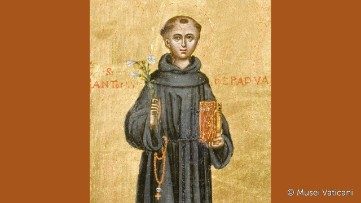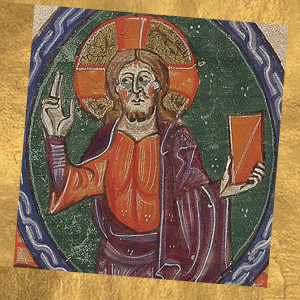Saint Anthony of Padua

Born into a noble family at Lisbon, Portugal, in 1195 (on August 15, it is believed), and baptized Fernando, the man we would come to know as St. Anthony was 15 years old when he entered the Canons Regular of St. Augustine. He was trained for the priesthood in Coimbra, in the monastery of the Holy Cross, and ordained at the age of 24. His early prospects strongly suggested an academic career: as a philosopher and theologian. He desired a more severe religious life, however. The turning point came in 1220 when the remains of five Franciscan missionaries tortured and killed in Morocco reached the church of the Holy Cross.
From the Augustinian rule to the Franciscan rule
Fernando decided to leave the Augustinian canons and follow in the footsteps of Francis of Assisi, choosing then to be called Anthony, in imitation of the great Desert Father of that name. He nurtured a powerful missionary zeal, on the strength of which he set out for Morocco. He took sick, however, and, forced to rest, he could not preach. There was nothing for it but to return to Italy. The ship carrying him was severely damaged at sea, though Anthony reached Sicily, where he was treated for his illness. In 1221, he reached Assisi, where Francis had summoned all his friars. This was his chance to meet Francis in person.Theirs is a straighforward encounter, in which Anthony’s decision to follow Christ in the Franciscan way was confirmed. He wass sent to Romagna, to the hermitage of Montepaolo, where he would be mainly devoted to prayer, meditation, penance and humble work.
Anthony the Preacher
In September 1222 Anthony was invited to preach in Forlì: there his gifts asa preacher would be on full display. His words revealed profound biblical knowledge and simplicity of expression. In the words of L’Assidua, the first biography of Saint Anthony, “His tongue, moved by the Holy Spirit, began to excogitate many arguments with ponderation, in a clear and concise manner." From that moment, Anthony began a stint as an itinerant preacher in northern Italy and the south of France, preaching the Gospel to people and countries often confused by the heresies of the day. He spared no words of correction for the moral decay of some Church members, either. The following year, in Bologna, he found himself in charge of the theological training of friars in formation. Francis himself gave Anthony the task, in a letter authorizing him to teach and recommending that he not neglect prayer.
The choice of Padua
Owing to the immense talents he brought to serve the Kingdom of God, Anthony was appointed - at the age of 32 - superior of the Franciscan fraternities of northern Italy. He visited the many houses under his jurisdiction, and opened new ones. Meanwhile, he continued to preach and attract large crowds. He would spend several hours in the confessional, and reserve moments to retire in solitude. He chose to reside in Padua, in the small Franciscan community of the church of Mater Domini, and quickly established a strong bond with the city, working for the poor and against injustice. It was in Padua that his Sermons was written, a treatise for the formation of his Franciscan confreres in the preaching of the Gospel and the teaching of the sacraments, especially Penance and the Eucharist. His Lenten preaching in 1231 has come to be considered his spiritual testament, along with his loving dedication, for hours and hours, to the hearing of confessions. After Easter, already experiencing health problems and made weary by the strain of labor, Anthony agreed to retire for a period of convalescence. With other confreres, he welcomed the invitation to a period of rest and meditation in a small hut in Camposampiero, a few kilometers from Padua. He asked that a simple shelter be fitted over a large walnut tree, that he might spend the days in contemplation and dialogue with the simple people of the countryside, returning to the hermitage only at night. There, he had his famous vision of the Child Jesus. On June 13, Antonio was caught up in a hurricane; he realized that his time was near, and he desired to die in Padua. He was transported in a wagon drawn by oxen, but died at Arcella, a settlement just outside the city. On his lips as he expired, were the whispered words, “I see my Lord.” Debtor to the thought of St. Augustine of Hippo, Anthony throughout his whole life lived the harmony of mind and heart, seeking the wisdom of speculation and practicing virtue, equally dedicated to study and prayer. A Doctor of the Church, in Padua he is is simply called “the Saint”.







